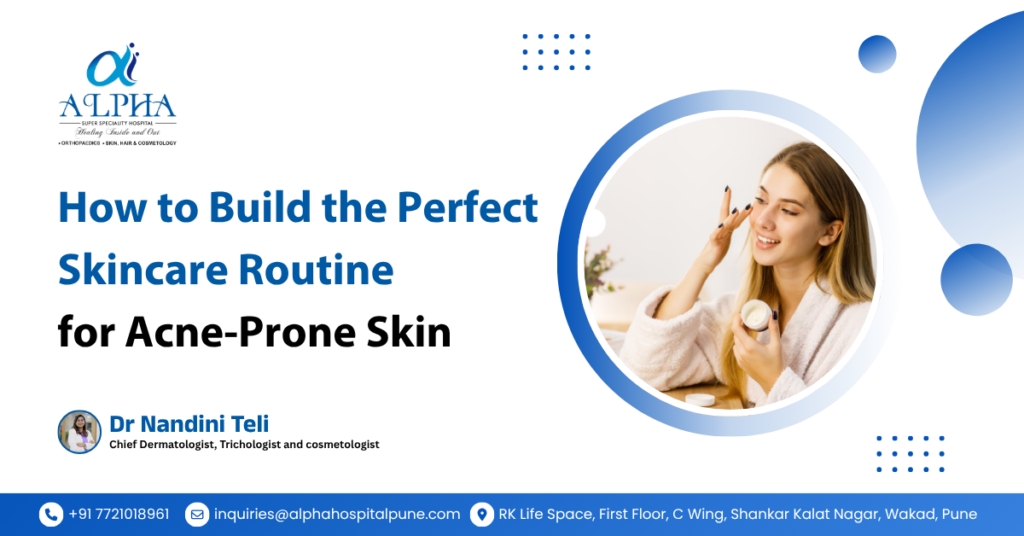Acne-prone skin needs extra care, patience, and the right skincare routine. Many people struggle with frequent breakouts, clogged pores, and uneven skin texture—but with the correct routine, you can control acne and achieve clear, glowing skin. In this blog, Dr. Nandini Teli, a leading dermatologist in Pune, explains how to build the perfect skincare routine for acne-prone skin that actually works.
1. Understand Your Skin Type
Before starting any skincare routine, it’s essential to know your skin type—whether it’s oily, dry, combination, or sensitive.
Most acne-prone skin tends to be oily, but dryness and irritation can still occur due to over-cleansing or harsh treatments.
Knowing your skin type helps you choose the right products that maintain your skin’s natural balance.
2. Cleanse Gently but Effectively
Cleansing is the first and most crucial step in any skincare routine.
Use a mild, non-comedogenic cleanser twice a day—once in the morning and once before bed.
Avoid harsh scrubs or alcohol-based products that can irritate your skin and trigger more acne.
Look for ingredients like:
- Salicylic Acid – Helps unclog pores.
- Benzoyl Peroxide – Kills acne-causing bacteria.
- Niacinamide – Reduces redness and inflammation.
Pro Tip by Dr. Nandini Teli: Never over-wash your face; this can strip natural oils and cause rebound oil production.
3. Use a Balancing Toner
A toner helps remove any leftover impurities and tightens your pores.
Choose alcohol-free toners with soothing ingredients like:
- Witch Hazel
- Green Tea
- Rose Water
These ingredients refresh your skin and prepare it for better absorption of serums and moisturizers.
4. Apply a Lightweight, Oil-Free Moisturizer
Moisturizing is a must, even for oily or acne-prone skin.
Skipping moisturizer can make your skin dehydrated, forcing it to produce more oil.
Opt for:
- Gel-based or water-based moisturizers
- Oil-free and non-comedogenic formulas
Ingredients to look for:
- Hyaluronic Acid
- Ceramides
- Aloe Vera
Expert Tip: Apply moisturizer right after cleansing to lock in hydration.
5. Target Acne with Serums or Treatments
After cleansing and moisturizing, you can use targeted acne treatments.
Choose products that contain:
- Retinoids (Vitamin A derivatives) – Prevent clogged pores.
- Niacinamide – Reduces inflammation.
- Azelaic Acid – Helps reduce acne scars and pigmentation.
Always start slowly with active ingredients to avoid irritation.
6. Never Skip Sunscreen
Sunscreen protects your skin from UV rays that can worsen acne marks and pigmentation.
Pick a broad-spectrum, oil-free sunscreen (SPF 30 or above).
Look for labels like “non-comedogenic” and “matte finish” to avoid clogging pores.
Dr. Teli recommends: Reapply sunscreen every 3–4 hours if you’re outdoors for long periods.
7. Weekly Exfoliation
Gentle exfoliation once or twice a week helps remove dead skin cells and prevents clogged pores.
Use chemical exfoliants (like AHAs or BHAs) instead of physical scrubs.
Avoid over-exfoliating, as it can damage your skin barrier and cause more breakouts.
8. Maintain a Healthy Lifestyle
A perfect skincare routine works best when supported by healthy habits.
- Drink plenty of water.
- Eat a balanced diet rich in fruits and vegetables.
- Avoid sugary and oily foods.
- Get adequate sleep and manage stress.
Remember: Healthy skin starts from within.
9. Consult a Dermatologist
If your acne is severe or persistent, it’s best to consult a dermatologist for personalized treatment.
Dr. Nandini Teli offers customized acne care plans including medical-grade treatments like:
- Chemical Peels
- Laser Therapy
- Prescription Medications
- Advanced Acne Scar Treatments
With the right guidance, you can achieve long-term control over acne and restore your skin’s confidence.
Final Thoughts
Building the perfect skincare routine for acne-prone skin isn’t about using the most expensive products—it’s about consistency, balance, and understanding your skin’s needs.
Follow this step-by-step routine and let your skin heal naturally.
And remember, clear skin takes time, but with expert advice from Dr. Nandini Teli, it’s absolutely achievable.

